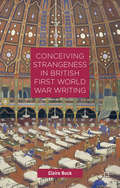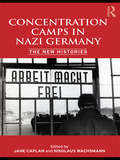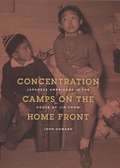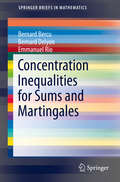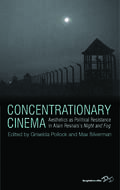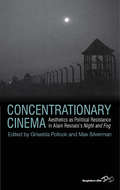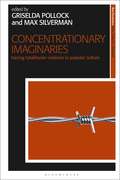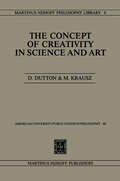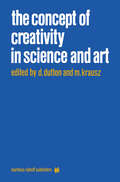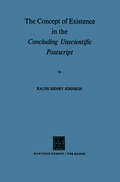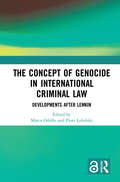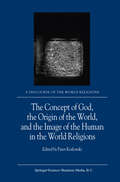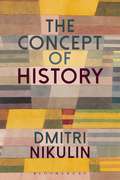- Table View
- List View
Conceiving Strangeness in British First World War Writing
by C. BuckThis book reframes British First World War literature within Britain's history as an imperial nation. Rereading canonical war writers Siegfried Sassoon and Edmund Blunden, alongside war writing by Enid Bagnold, E. M. Forster, Mulk Raj Anand, Roly Grimshaw and others, the book makes clear that the Great War was more than a European war.
Concentration Camp Survivors in Norway and Israel
by Leo EitingerThe general background of the groups investigated The purpose of this paper is to examine whether the severe psychic and physical stress situations to which human beings were exposed in the concentration camps of World \Var II have had lasting psychological results, to discover the nature of these conditions and the symptomatology they present, and finally to investigate which detailed factors of the above-mentioned stress situation can be con sidered decisive for the morbid conditions which were revealed. In order to elucidate these questions from different points of view, I have examined groups of former concentration camp inmates both in Norway and Israel. The Norwegians who were examined compose a fairly uniform group of men and women, born and bred in Norway, who after the War naturally returned to their native country. The Israeli groups which were examined were drawn from almost every country in Europe that had been under German occupation during World War II. They had all immigrated into Israel, mostly after 1948.
Concentration Camps: A Short History
by Dan StoneConcentration camps are a relatively new invention, a recurring feature of twentieth century warfare, and one that is important to the modern global consciousness and identity. Although the most famous concentration camps are those under the Nazis, the use of concentration camps originated several decades before the Third Reich, in the Philippines and in the Boer War, and they have been used again in numerous locations, not least during the genocide in Bosnia. They have become defining symbols of humankind's lowest point and basest acts. In this book, Dan Stone gives a global history of concentration camps, and shows that it is not only "mad dictators " who have set up camps, but instead all varieties of states, including liberal democracies, that have made use of them. Setting concentration camps against the longer history of incarceration, he explains how the ability of the modern state to control populations led to the creation of this extreme institution. Looking at their emergence and spread around the world, Stone argues that concentration camps serve the purpose, from the point of view of the state in crisis, of removing a section of the population that is perceived to be threatening, traitorous, or diseased. Drawing on contemporary accounts of camps, as well as the philosophical literature surrounding them, Stone considers the story camps tell us about the nature of the modern world as well as about specific regimes.
Concentration Camps: A Short History
by Dan StoneConcentration camps are a relatively new invention, a recurring feature of twentieth century warfare, and one that is important to the modern global consciousness and identity. Although the most famous concentration camps are those under the Nazis, the use of concentration camps originated several decades before the Third Reich, in the Philippines and in the Boer War, and they have been used again in numerous locations, not least during the genocide in Bosnia. They have become defining symbols of humankind's lowest point and basest acts. In this book, Dan Stone gives a global history of concentration camps, and shows that it is not only "mad dictators " who have set up camps, but instead all varieties of states, including liberal democracies, that have made use of them. Setting concentration camps against the longer history of incarceration, he explains how the ability of the modern state to control populations led to the creation of this extreme institution. Looking at their emergence and spread around the world, Stone argues that concentration camps serve the purpose, from the point of view of the state in crisis, of removing a section of the population that is perceived to be threatening, traitorous, or diseased. Drawing on contemporary accounts of camps, as well as the philosophical literature surrounding them, Stone considers the story camps tell us about the nature of the modern world as well as about specific regimes.
Concentration Camps in Nazi Germany: The New Histories
by Jane Caplan Nikolaus WachsmannThe notorious concentration camp system was a central pillar of the Third Reich, supporting the Nazi war against political, racial and social outsiders whilst also intimidating the population at large. Established during the first months of the Nazi dictatorship in 1933, several million men, women and children of many nationalities had been incarcerated in the camps by the end of the Second World War. At least two million lost their lives. This comprehensive volume offers the first overview of the recent scholarship that has changed the way the camps are studied over the last two decades. Written by an international team of experts, the book covers such topics as the earliest camps; social life, work and personnel in the camps; the public face of the camps; issues of gender and commemoration; and the relationship between concentration camps and the Final Solution. The book provides a comprehensive introduction to the current historiography of the camps, highlighting the key conclusions that have been made, commenting on continuing areas of debate, and suggesting possible directions for future research.
Concentration Camps in Nazi Germany: The New Histories
by Nikolaus Wachsmann Jane CaplanThe notorious concentration camp system was a central pillar of the Third Reich, supporting the Nazi war against political, racial and social outsiders whilst also intimidating the population at large. Established during the first months of the Nazi dictatorship in 1933, several million men, women and children of many nationalities had been incarcerated in the camps by the end of the Second World War. At least two million lost their lives. This comprehensive volume offers the first overview of the recent scholarship that has changed the way the camps are studied over the last two decades. Written by an international team of experts, the book covers such topics as the earliest camps; social life, work and personnel in the camps; the public face of the camps; issues of gender and commemoration; and the relationship between concentration camps and the Final Solution. The book provides a comprehensive introduction to the current historiography of the camps, highlighting the key conclusions that have been made, commenting on continuing areas of debate, and suggesting possible directions for future research.
Concentration Camps on the Home Front: Japanese Americans in the House of Jim Crow
by John HowardWithout trial and without due process, the United States government locked up nearly all of those citizens and longtime residents who were of Japanese descent during World War II. Ten concentration camps were set up across the country to confine over 120,000 inmates. Almost 20,000 of them were shipped to the only two camps in the segregated South—Jerome and Rohwer in Arkansas—locations that put them right in the heart of a much older, long-festering system of racist oppression. The first history of these Arkansas camps, Concentration Camps on the Home Front is an eye-opening account of the inmates’ experiences and a searing examination of American imperialism and racist hysteria. While the basic facts of Japanese-American incarceration are well known, John Howard’s extensive research gives voice to those whose stories have been forgotten or ignored. He highlights the roles of women, first-generation immigrants, and those who forcefully resisted their incarceration by speaking out against dangerous working conditions and white racism. In addition to this overlooked history of dissent, Howard also exposes the government’s aggressive campaign to Americanize the inmates and even convert them to Christianity. After the war ended, this movement culminated in the dispersal of the prisoners across the nation in a calculated effort to break up ethnic enclaves. Howard’s re-creation of life in the camps is powerful, provocative, and disturbing. Concentration Camps on the Home Front rewrites a notorious chapter in American history—a shameful story that nonetheless speaks to the strength of human resilience in the face of even the most grievous injustices.
Concentration Camps on the Home Front: Japanese Americans in the House of Jim Crow
by John HowardWithout trial and without due process, the United States government locked up nearly all of those citizens and longtime residents who were of Japanese descent during World War II. Ten concentration camps were set up across the country to confine over 120,000 inmates. Almost 20,000 of them were shipped to the only two camps in the segregated South—Jerome and Rohwer in Arkansas—locations that put them right in the heart of a much older, long-festering system of racist oppression. The first history of these Arkansas camps, Concentration Camps on the Home Front is an eye-opening account of the inmates’ experiences and a searing examination of American imperialism and racist hysteria. While the basic facts of Japanese-American incarceration are well known, John Howard’s extensive research gives voice to those whose stories have been forgotten or ignored. He highlights the roles of women, first-generation immigrants, and those who forcefully resisted their incarceration by speaking out against dangerous working conditions and white racism. In addition to this overlooked history of dissent, Howard also exposes the government’s aggressive campaign to Americanize the inmates and even convert them to Christianity. After the war ended, this movement culminated in the dispersal of the prisoners across the nation in a calculated effort to break up ethnic enclaves. Howard’s re-creation of life in the camps is powerful, provocative, and disturbing. Concentration Camps on the Home Front rewrites a notorious chapter in American history—a shameful story that nonetheless speaks to the strength of human resilience in the face of even the most grievous injustices.
Concentration Camps: A Very Short Introduction (Very Short Introductions)
by Dan StoneConcentration camps are a relatively new invention, a recurring feature of twentieth century warfare, and one that is important to the modern global consciousness and identity. Although the most famous concentration camps are those under the Nazis, the use of concentration camps originated several decades before the Third Reich, in the Philippines and in the Boer War, and they have been used again in numerous locations, not least during the genocides in Bosnia and Rwanda. Over the course of the twentieth century they have become defining symbols of humankind's lowest point and basest acts. In this Very Short Introduction, Dan Stone gives a global history of concentration camps, and shows that it is not only "mad dictators" who have set up camps, but instead all varieties of states, including liberal democracies, that have made use of them. Setting concentration camps against the longer history of incarceration, he explains how the ability of the modern state to control populations led to the creation of this extreme institution. Looking at their emergence and spread around the world, Stone argues that concentration camps serve the purpose, from the point of view of the state in crisis, of removing a section of the population that is perceived to be threatening, traitorous, or diseased. Drawing on contemporary accounts of camps, as well as the philosophical literature surrounding them, Stone considers the story camps tell us about the nature of the modern world as well as about specific regimes. ABOUT THE SERIES: The Very Short Introductions series from Oxford University Press contains hundreds of titles in almost every subject area. These pocket-sized books are the perfect way to get ahead in a new subject quickly. Our expert authors combine facts, analysis, perspective, new ideas, and enthusiasm to make interesting and challenging topics highly readable.
Concentration Camps: A Very Short Introduction (Very Short Introductions)
by Dan StoneConcentration camps are a relatively new invention, a recurring feature of twentieth century warfare, and one that is important to the modern global consciousness and identity. Although the most famous concentration camps are those under the Nazis, the use of concentration camps originated several decades before the Third Reich, in the Philippines and in the Boer War, and they have been used again in numerous locations, not least during the genocides in Bosnia and Rwanda. Over the course of the twentieth century they have become defining symbols of humankind's lowest point and basest acts. In this Very Short Introduction, Dan Stone gives a global history of concentration camps, and shows that it is not only "mad dictators" who have set up camps, but instead all varieties of states, including liberal democracies, that have made use of them. Setting concentration camps against the longer history of incarceration, he explains how the ability of the modern state to control populations led to the creation of this extreme institution. Looking at their emergence and spread around the world, Stone argues that concentration camps serve the purpose, from the point of view of the state in crisis, of removing a section of the population that is perceived to be threatening, traitorous, or diseased. Drawing on contemporary accounts of camps, as well as the philosophical literature surrounding them, Stone considers the story camps tell us about the nature of the modern world as well as about specific regimes. ABOUT THE SERIES: The Very Short Introductions series from Oxford University Press contains hundreds of titles in almost every subject area. These pocket-sized books are the perfect way to get ahead in a new subject quickly. Our expert authors combine facts, analysis, perspective, new ideas, and enthusiasm to make interesting and challenging topics highly readable.
Concentration Inequalities for Sums and Martingales (SpringerBriefs in Mathematics)
by Bernard Bercu Bernard Delyon Emmanuel RioThe purpose of this book is to provide an overview of historical and recent results on concentration inequalities for sums of independent random variables and for martingales.The first chapter is devoted to classical asymptotic results in probability such as the strong law of large numbers and the central limit theorem. Our goal is to show that it is really interesting to make use of concentration inequalities for sums and martingales.The second chapter deals with classical concentration inequalities for sums of independent random variables such as the famous Hoeffding, Bennett, Bernstein and Talagrand inequalities. Further results and improvements are also provided such as the missing factors in those inequalities.The third chapter concerns concentration inequalities for martingales such as Azuma-Hoeffding, Freedman and De la Pena inequalities. Several extensions are also provided.The fourth chapter is devoted to applications of concentration inequalities in probability and statistics.
Concentrationary Art: Jean Cayrol, the Lazarean and the Everyday in Post-war Film, Literature, Music and the Visual Arts
by Griselda Pollock and Max SilvermanLargely forgotten over the years, the seminal work of French poet, novelist and camp survivor Jean Cayrol has experienced a revival in the French-speaking world since his death in 2005. His concept of a concentrationary art—the need for an urgent and constant aesthetic resistance to the continuing effects of the concentrationary universe—proved to be a major influence for Hannah Arendt and other writers and theorists across a number of disciplines. Concentrationary Art presents the first translation into English of Jean Cayrol’s key essays on the subject, as well as the first book-length study of how we might situate and elaborate his concept of a Lazarean aesthetic in cultural theory, literature, cinema, music and contemporary art.
Concentrationary Cinema: Aesthetics as Political Resistance in Alain Resnais's <I>Night and Fog</I>
by Griselda Pollock Max SilvermanSince its completion in 1955, Alain Resnais’s Night and Fog (Nuit et Brouillard) has been considered one of the most important films to confront the catastrophe and atrocities of the Nazi era. But was it a film about the Holocaust that failed to recognize the racist genocide? Or was the film not about the Holocaust as we know it today but a political and aesthetic response to what David Rousset, the French political prisoner from Buchenwald, identified on his return in 1945 as the ‘concentrationary universe’ which, now actualized, might release its totalitarian plague any time and anywhere? What kind of memory does the film create to warn us of the continued presence of this concentrationary universe? This international collection re-examines Resnais’s benchmark film in terms of both its political and historical context of representation of the camps and of other instances of the concentrationary in contemporary cinema. Through a range of critical readings, Concentrationary Cinema explores the cinematic aesthetics of political resistance not to the Holocaust as such but to the political novelty of absolute power represented by the concentrationary system and its assault on the human condition.
Concentrationary Cinema: Aesthetics as Political Resistance in Alain Resnais's <I>Night and Fog</I>
by Griselda Pollock Max SilvermanSince its completion in 1955, Alain Resnais’s Night and Fog (Nuit et Brouillard) has been considered one of the most important films to confront the catastrophe and atrocities of the Nazi era. But was it a film about the Holocaust that failed to recognize the racist genocide? Or was the film not about the Holocaust as we know it today but a political and aesthetic response to what David Rousset, the French political prisoner from Buchenwald, identified on his return in 1945 as the ‘concentrationary universe’ which, now actualized, might release its totalitarian plague any time and anywhere? What kind of memory does the film create to warn us of the continued presence of this concentrationary universe? This international collection re-examines Resnais’s benchmark film in terms of both its political and historical context of representation of the camps and of other instances of the concentrationary in contemporary cinema. Through a range of critical readings, Concentrationary Cinema explores the cinematic aesthetics of political resistance not to the Holocaust as such but to the political novelty of absolute power represented by the concentrationary system and its assault on the human condition.
Concentrationary Imaginaries: Tracing Totalitarian Violence in Popular Culture (New Encounters: Arts, Cultures, Concepts)
by Griselda Pollock Max SilvermanWhat defines 'quality' in contemporary Hollywood film? Although often seen as inhospitable to such work, the studios of the blockbuster-franchise era continue to produce features that make claims to higher status. Films such as The Social Network, The Assassination of Jesse James by the Coward Robert Ford and Mystic River are marked as distinctive from the mainstream norm. But how exactly, and how are such qualities mixed with more familiar Hollywood ingredients, as found in larger doses in other examples such as Blood Diamond and the blockbuster-scale Inception?Quality Hollywood is the first book to address these issues, featuring close analysis of case study films, critical responses and the wider notions of cultural value on which these draw. Geoff King argues that such films retain a presence as a minority strand of studio output. The reasons for this combine factors relating to economics, the power of certain filmmakers and Hollywood's investment in its own prestige.
Concentrationary Memories: Totalitarian Terror and Cultural Resistance (New Encounters: Arts, Cultures, Concepts)
by Max Silvermann Griselda PollockIn 1945, French political prisoners returning from the concentration camps of Germany coined the phrase 'the concentrationary universe' to describe the camps as a terrible political experiment in the destruction of the human. This book shows how the unacknowledged legacy of a totalitarian mentality has seeped into the deepest recesses of everyday popular culture. It asks if the concentrationary now infests our cultural imaginary, normalizing what was once considered horrific and exceptional by transforming into entertainment violations of human life.
The Concept of Coherence in Art
by L. AschenbrennerThis book concerns a single topic, coherence in the several arts, which is vague to begin with, but becomes progressively more precise as we proceed. While the book is not a formalist theory of art it aims to take steps toward clearing up the concept of form, which is of central interest in art, either by its observance or by deliberate defiance. While our interest is thus in one concept, it is as a matter of fact complex and covers some seven subordinate topics. Each of these important subjects is covered in separate chapters: the number of principal parts of artworks, their extent, size or magnitude, the intervallic relation between them, and their dimensional, contextual, tendentive, and connotational relations, all of which will be explained as we proceed. There are ample analyses or critiques devoted to particular artworks which appear in Part Two. While the book keeps to a fairly narrow range of subjects, breadth is there too, and the implication for all the arts is manifest. The examples cover mainly music, but there is a broad selection of architecture, sculpture, painting, both abstract and figural, and a brief selection from the field of narrative poetic art. Many more types of the arts had to be excluded to make the book of manageable size.
The Concept of Creativity in Science and Art (Martinus Nijhoff Philosophy Library #6)
by Denis Dutton Michael KrauszThe Concept of Creativity in Science and Art (Martinus Nijhoff Philosophy Library #6)
by MichaelKrausz DenisDuttonThis third volume of American University Publications in Philos ophy continues the tradition of presenting books in the series shaping current frontiers and new directions in phi. osophical reflection. In a period emerging from the neglect of creativity by positivism, Professors Dutton and Krausz and their eminent colleagues included in the collection challenge modern philosophy to explore the concept of creativity in both scientific inquiry and artistic production. In view of the fact that Professor Krausz served at one time as Visiting Professor of Philosophy at The American University we are especially pleased to include this volume in the series. HAROLD A. DURFEE, for the editors of American University Publications in Philosophy EDITORS' PREFACE While the literature on the psychology of creativity is substantial, surprisingly little attention has been paid to the subject by philos ophers in recent years. This fact is no doubt owed in 'part to the legacy of positivism, whose tenets have included a sharp distinction between what Hans Reichenbach called the context of discovery and the context of justification. Philosophy in this view must address itself to the logic of justifying hypotheses; little of philo sophical importance can be said about the more creative business of discovering them. That, positivism has held, is no more than a merely psychological question: since there is no logic of discovery or creation, there can be no philosophical reconstruction of it.
The Concept of Existence in the Concluding Unscientific Postscript
by R.H. JohnsonThe writings of Kierkegaard continue to be a fertile source for con temporary philosophical thought. Perhaps the most interesting of his works to a philosopher is the Concluding Unscientific Postscript to the Philosophical Fragments. The Fragments is a brief, algebraic piece in which the author attempts to put forward the central teachings of Christianity in philosophical terminology. The. work is addressed to a reader who has a philosophical bent and who may therefore be tempted to relate to Christianity via such questions as: Can the truth of Christian ity be established? The analysis of the Fragments establishes that this way of relating to Christianity is misguided, since Christianity and phil osophy are categorically different. Having done this, the author turns his attention in the Postscript to the question of how an individual human being can properly establish a relationship to Christianity. In order to become a Christian, one must first of all exist. "Nothing more than thatP' one may be tempted to think. Yet at the very core of the Postscript is the notion that to exist as an individual human being is difficult. The author goes so far as to claim that men have forgotten what it means to exist.
The Concept of Genocide in International Criminal Law: Developments after Lemkin
by Marco OdelloThis book presents a review of historical and emerging legal issues that concern the interpretation of the international crime of genocide. The Polish legal expert Raphael Lemkin formulated the concept of genocide during the Nazi occupation of Europe, and it was then incorporated into the 1948 Convention on the Prevention and Punishment of the Crime of Genocide. This volume looks at the issues that are raised both by the existing international law definition of genocide and by the possible developments that continue to emerge under international criminal law. The authors consider how the concept of genocide might be used in different contexts, and see whether the definition in the 1948 convention may need some revision, also in the light of the original ideas that were expressed by Lemkin. The book focuses on specific themes that allow the reader to understand some of the problems related to the legal definition of genocide, in the context of historical and recent developments. As a valuable contribution to the debate on the significance, meaning and application of the crime of genocide the book will be essential reading for students and academics working in the areas of Legal History, International Criminal Law, Human Rights, and Genocide Studies.
The Concept of Genocide in International Criminal Law: Developments after Lemkin
by Marco Odello Piotr 321 Ubi 324 SkiThis book presents a review of historical and emerging legal issues that concern the interpretation of the international crime of genocide. The Polish legal expert Raphael Lemkin formulated the concept of genocide during the Nazi occupation of Europe, and it was then incorporated into the 1948 Convention on the Prevention and Punishment of the Crime of Genocide. This volume looks at the issues that are raised both by the existing international law definition of genocide and by the possible developments that continue to emerge under international criminal law. The authors consider how the concept of genocide might be used in different contexts, and see whether the definition in the 1948 convention may need some revision, also in the light of the original ideas that were expressed by Lemkin. The book focuses on specific themes that allow the reader to understand some of the problems related to the legal definition of genocide, in the context of historical and recent developments. As a valuable contribution to the debate on the significance, meaning and application of the crime of genocide the book will be essential reading for students and academics working in the areas of Legal History, International Criminal Law, Human Rights, and Genocide Studies.
The Concept of God, the Origin of the World, and the Image of the Human in the World Religions (A Discourse of the World Religions #1)
by PeterKoslowskiAll religions make statements about God or the Absolute and about "the beginning": about the beginning of the world and the beginning and nature of the human person. Propositions about God, the human person, and the world, statements about God's eternity or process of becoming, about the status and nature of the human person as the "image of God", and about the beginning of the world are woven into "religious speculations about the beginning". The theology, anthropology, and cosmology of the world religions determine the image of the human person and the image of the world in the world cultures shaped by the different religions. They stand in a tense relationship with the anthropologies and cosmologies of modern science, which in turn challenge the religions to deepen their image of the human person. With this volume leading thinkers of Hinduism, Buddhism, Judaism, Christianity, and Islam provide the reader with a first-hand source for understanding the five world religions and their teaching about God, the human person, and the origin of the world.
The Concept of History
by Dmitri NikulinThe Concept of History reflects on the presuppositions behind the contemporary understanding of history that often remain implicit and not spelled out. It is a critique of the modern understanding of history that presents it as universal and teleological, progressively moving forward to an end. Although few contemporary philosophers and historians maintain the view that there is strict universality and teleology in history, the remnants of these positions still affect our understanding of history. But if history is not universal and singular, evolving toward an objective universal end, it should be possible to admit of multiple histories, some of which we appropriate as our own. An another important aspect of this book is that if provides an account of history that is itself both historical and rooted in attempts to narrate and explain history from its inception in antiquity. The book seeks to establish features or constituents of history that might be found in any historical account and might themselves be considered historical invariants in history.
The Concept of History: How Ideas Are Constituted, Transmitted And Interpreted
by Dmitri NikulinThe Concept of History reflects on the presuppositions behind the contemporary understanding of history that often remain implicit and not spelled out. It is a critique of the modern understanding of history that presents it as universal and teleological, progressively moving forward to an end. Although few contemporary philosophers and historians maintain the view that there is strict universality and teleology in history, the remnants of these positions still affect our understanding of history. But if history is not universal and singular, evolving toward an objective universal end, it should be possible to admit of multiple histories, some of which we appropriate as our own. An another important aspect of this book is that if provides an account of history that is itself both historical and rooted in attempts to narrate and explain history from its inception in antiquity. The book seeks to establish features or constituents of history that might be found in any historical account and might themselves be considered historical invariants in history.
